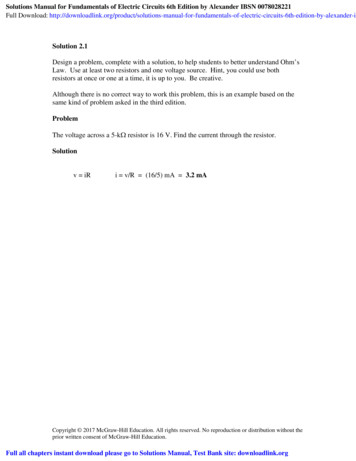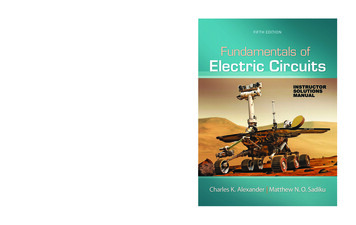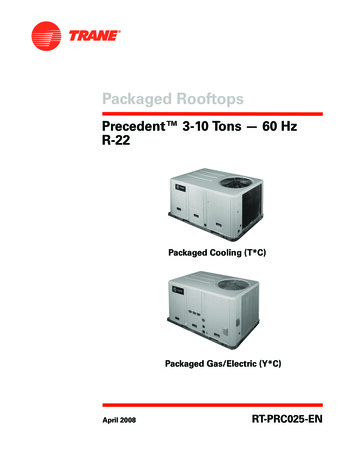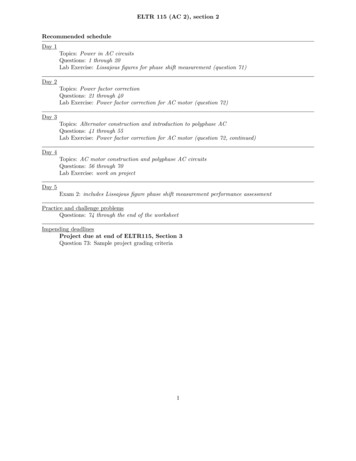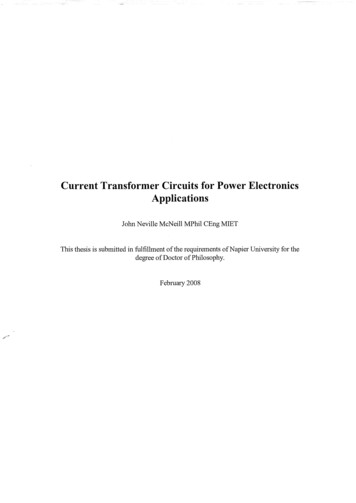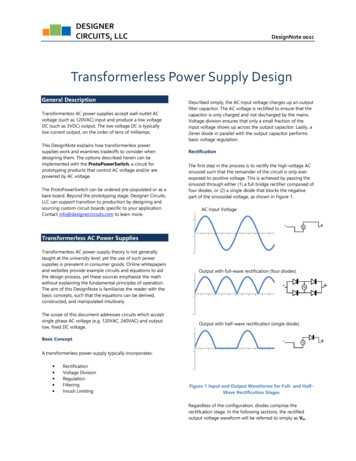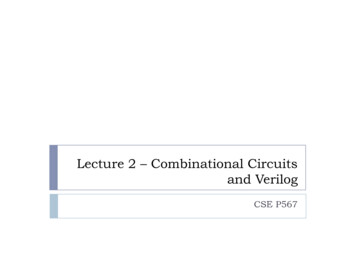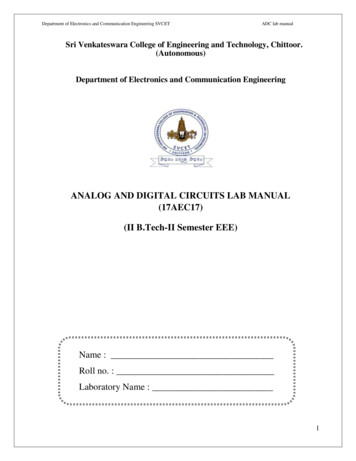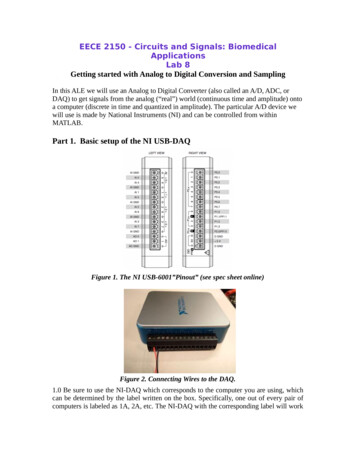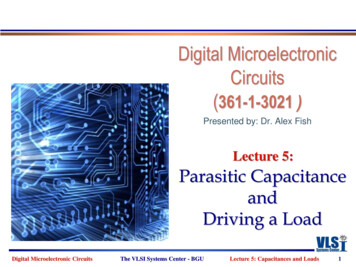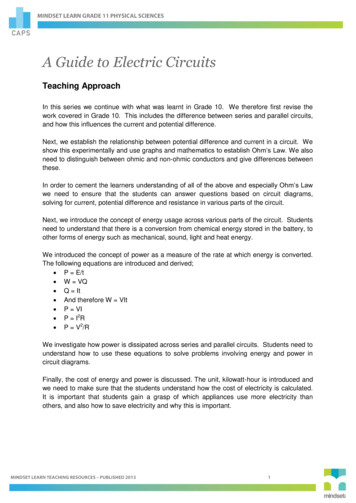
Transcription
A Guide to Electric CircuitsTeaching ApproachIn this series we continue with what was learnt in Grade 10. We therefore first revise thework covered in Grade 10. This includes the difference between series and parallel circuits,and how this influences the current and potential difference.Next, we establish the relationship between potential difference and current in a circuit. Weshow this experimentally and use graphs and mathematics to establish Ohm’s Law. We alsoneed to distinguish between ohmic and non-ohmic conductors and give differences betweenthese.In order to cement the learners understanding of all of the above and especially Ohm’s Lawwe need to ensure that the students can answer questions based on circuit diagrams,solving for current, potential difference and resistance in various parts of the circuit.Next, we introduce the concept of energy usage across various parts of the circuit. Studentsneed to understand that there is a conversion from chemical energy stored in the battery, toother forms of energy such as mechanical, sound, light and heat energy.We introduced the concept of power as a measure of the rate at which energy is converted.The following equations are introduced and derived; P E/t W VQ Q It And therefore W VIt P VI P I2R P V2/RWe investigate how power is dissipated across series and parallel circuits. Students need tounderstand how to use these equations to solve problems involving energy and power incircuit diagrams.Finally, the cost of energy and power is discussed. The unit, kilowatt-hour is introduced andwe need to make sure that the students understand how the cost of electricity is calculated.It is important that students gain a grasp of which appliances use more electricity thanothers, and also how to save electricity and why this is important.
Video SummariesSome videos have a ‘PAUSE’ moment, at which point the teacher or learner can choose topause the video and try to answer the question posed or calculate the answer to the problemunder discussion. Once the video starts again, the answer to the question or the right answerto the calculation is givenMindset suggests a number of ways to use the video lessons. These include: Watch or show a lesson as an introduction to a lesson Watch or show a lesson after a lesson, as a summary or as a way of adding in someinteresting real-life applications or practical aspects Design a worksheet or set of questions about one video lesson. Then ask learners towatch a video related to the lesson and to complete the worksheet or questions, either ingroups or individually Worksheets and questions based on video lessons can be used as short assessments orexercises Ask learners to watch a particular video lesson for homework (in the school library or onthe website, depending on how the material is available) as preparation for the next day’slesson; if desired, learners can be given specific questions to answer in preparation forthe next day’s lesson1. Grade 10 RevisionThis lesson serves to recap the following Grade 10 principles: What makes an object positively or negatively charged Principle of conservation of charge Charge quantisation2. Ohm’s LawIn this lesson we experimentally investigate the relationship between current and potentialdifference across an ohmic resistor. We analyse the results both mathematically as wellas graphically, and Ohm’s Law is concluded3. Non-Ohmic ResistorsIn this lesson we experimentally investigate the relationship between current and potentialdifference across light bulbs. We analyse the results both mathematically as well asgraphically.4. Ohm’s Law CalculationsIn this video we address circuit problems and use Ohm’s Law as well as our knowledge ofhow resistance is calculated in series and parallel to solve these problems.5. Electrical Energy and PowerIn this lesson the concept of energy conversion is introduced. We cover the conversion ofchemical energy (stored inside the batteries) to other forms of energy such as mechanical(to move fans), heat (heaters) and light (light bulbs).
6. Power in Series CircuitsIn this video we experimentally investigate how power is dissipated as we add more lightbulbs in a series circuit. We learn that the more light bulbs we add in series, the dimmerthey become.7. Power in Parallel CircuitsIn this lesson we experimentally investigate how power is dissipated as we add more lightbulbs in a parallel circuit. To be thorough, we measure the current in both the main circuitas well as in each branch.8. Energy and Power CalculationsWe work through an example where we use our combined knowledge of Ohm’s Law,resistance in series and parallel, and energy and power to solve circuit diagram problems.9. Paying for ElectricityWe discuss the cost of electrical energy. The kilowatt-hour unit is introduced.Calculations using the kilowatt-hour to calculate the cost of electrical energy are done.We also look at the power consumption of various household appliances.
Resource Material1. Grade 10 Revision2. Ohm’s Law3. Non-ohmic Resistors4. Ohm’s Law circuits/u9l2c.cfmA lesson on electric voltage.htmThis page defines .htmlNotes on series and parallel /elessonsHTML/Resist/Resist2.htmlA u/hbase/electric/ohmlaw.htmlThis page looks at Ohm’s wFun, interactive, research-basedsimulations of Ohm’s law.http://www.hamuniverse.com/ohmslaw.htmlThis Physics/NZphysics%20HTML/14 Electronics/chapter14a.htmlThis page looks at ohmic and nonohmic dex?qid 20110831223619AAKM3kmHere we look at what makes aresistor id 20090427032506AAQtKzQThe difference between ohmic andnon ohmic is site provides students calculationsoncombinationsexplainsOhm’soflaw
5. ElectricalPowerEnergyand6. Power in Series Circuits7. Power in Parallel aw.htmA resource on ohm’s law.http://sunburst.usd.edu/ schieber/psyc770/resistors/ohms4beginner.htmlThis page defines ohm’s law andlooks at how and where it can ject.aspx?ID dce11904Ohm’s law practice problems.http://inst.eecs.berkeley.edu/ ee42/sp01/LectNotes/Lect6.PDFLecture notes on power and energyin electric nces/PhysSci/done/electric/power/Power.htmThis page looks at power and energyin iles/research/cssme/nstu/voltage energy power in electric circuits.pdfA learner resource on voltage,energy and power in electric cal-formulas-d 455.htmlThe most common used tronicsclub.info/power.htmA resource on power and 13.htmPower in series id 20090527180032AANKyj9How to find power in a series circuit.http://wiki.answers.com/Q/Is the power dissipated in a series circuit is equal to the sum of the power dissipated by each resistances in the circuitThis page looks at whether thepower dissipated in a series circuit isequal to the sum of the powerdissipated by each resistance in pt 5/5.htmlPower calculations.
8. EnergyandCalculations9. Paying for apter3/1-27.htmPower in a parallel llel-Circuit/This page looks at power dissipationin a parallel llel circuits.htmA course on parallel id 20110320130537AASvzeqThis site looks at how to calculatepower in a parallel and series ct.aspx?id dce2202Power calculations in aseries/parallel ct.aspx?id dce2202Power calculations in aseries/parallel kwhAn explanation of kW and lThis page explains a ommon appliance Wattages .pdfA list of common appliances, theirwattage and an estimate ofoperating ating-appliance-and-homeelectronic-energy-useThis page estimates appliance andhome electric energy use.
TaskQuestion 1The switch is open.1.1 Calculate the resistance in the parallel network.1.2 Calculate the reading on the ammeter.1.3 Calculate the reading on the voltmeter1.4 Calculate the amount of heat released by the 12Ω resistor in 5 minutes.1.5 Calculate the current in the 4Ω resistor.The switch is now closed.1.6 Calculate the current in the circuit.1.7 Explain what will happen to the 2A fuse using the concept of power.Question 2A 960 W heater and a 192 W television are connected in parallel to a 240 V householdpower socket. A circuit breaker is a device which breaks the current if a certain current isreached. This is to stop fires caused by overheated wires in a house. The circuit breaker inthis house is set to trip at 5 A.2.1 Calculate the current flowing in each appliance.2.2 Calculate the resistance of the heater.2.3 Will the circuit breaker trip. Explain using a calculation.2.4 Will the circuit breaker trip if an iron marked 1000 W is connected in parallel to this set?Justify your answer with a calculation.
Question 3Consider the circuit below. The cell is marked 6 V, and the reading on the voltmeter is 4,57 V.3.1 Calculate the reading on A.3.2 Hence, or otherwise, calculate the resistance of B.Question 4It takes 4,05 x 105 J to boil 1250 ml of water.4.1 How long will it take to boil this water if you use a kettle marked 2500 W?4.2 If the cost of electricity is R1,78 per kWh, calculate how much it will cost to heat thiswater.
Task AnswersQuestion 11.1 Rp 3Ω1.2I 1A1.3V IR 1 X 3 3V1.4W 1.5 R I 0,75 AThe switch is now closed.1.6 Rp 2,25 Ω1.7 The power allowed in the circuit is P VI 12 x 2 24 W.When the switch is closed the power drawn by the circuit is P VI 12(2,29) 27,5 WTherefore the fuse will melt (or blow).Question 22.1 Heater:P VI ; 960 240 X I; I 4 ATV:P VI; 192 240 x I; I 0,8 A2.222P V /R ; 960 (240) /R; R 60 Ω2.3 Total current 4A 0,8 A 4,8 A. This is less than 5 A so no, circuit breaker will not trip.2.4 Iron: P VI; 1000 240/I; I 4,2 ATotal current is now 4,2 4 0,8 9 A. Since this is more than the 5 A it will trip.Question 33.1 Consider the 12 Ω resistor: I V/R; I 4.57/12 0,38 A3.2 Hence, or otherwise, calculate the resistance of B.Vtotal VParallel V12Ω6 Vparallel 4,57Therefore, Vparallel 1,43 VNow consider the parallel set:Rp V/I 1,43/0,38 3,76 ΩBut
RB 6 ΩQuestion 454.1 t W/P 4.05 x 10 /2500 162 s 2 min 42 s.4.2 P 2,5 kW.t 162 s 0,045 h.The energy used to boil the water is then W E Pt 2,5 x 0,045 0,1125 kWhThe cost of which is 0,1125 x R1,78 R0,20 or 20 cents.
AcknowledgementsMindset Learn Executive HeadContent Manager Classroom ResourcesContent Coordinator Classroom ResourcesContent AdministratorContent DeveloperContent ReviewersDylan BusaJenny LamontHelen RobertsonAgness MunthaliCandace RennieTara JonesLiz HarrisProduced for Mindset Learn by TrafficFacilities CoordinatorProduction ManagerDirectorEditorPresenterStudio CrewGraphicsCezanne ScheepersBelinda RenneyAlriette GibbsNonhlanhla NxumaloBanji LongweAbram TjaleJames TselapediWilson MthembuWayne SandersonCreditsPhet Animations: http://phet.colorado.eduThis resource is licensed under a Attribution-Share Alike 2.5 South Africa mons
A Guide to Electric Circuits Teaching Approach In this series we continue with what was learnt in Grade 10. We therefore first revise the work covered in Grade 10.
